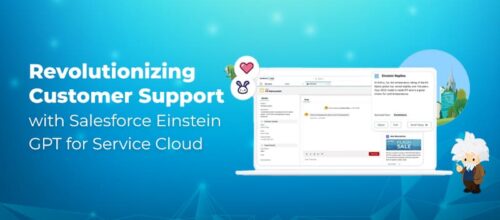Understanding Salesforce’s OmniStudio Data Raptors, Types, and Functionalities
Lala Asif Allana
Director of Technology – SalesforceJanuary 8, 2025
Accelerate Your eCommerce Business with Salesforce
Home » Blogs » Salesforce » Understanding Salesforce’s OmniStudio Data Raptors, Types, and Functionalities
OmniStudio DataRaptors essentially supply data to OmniScripts and Flex Cards from Salesforce and write updates from OmniScripts and Flex Cards back to Salesforce. Typically, they do this via OmniStudio Integration Procedures and are one of the primary components of OmniStudio’s Service Management layer.

What is an OmniStudio DataRaptor?
A Salesforce OmniStudio DataRaptor is a mapping tool that enables users to read, transform, and write Salesforce data. For every customer interaction or business process, the system must extract data to display it. Then, when users change that data or enter new data, it must be saved too. That’s where OmniStudio DataRaptors prove to be highly effective. Below is an example of how the data flows:
- Get Data: An OmniScript calls a DataRaptor Extract via an Integration Procedure to read the data from Salesforce. For example, an Edit Account OmniScript must display data such as the Account Name, Phone Number, and Website.
- Manipulate Data: The OmniScript captures the changed and new data based on the user inputs. For example, an agent changes the Phone Number on the Account.
- Save Data: The OmniScript calls a DataRaptor Load via an Integration Procedure to write data back to Salesforce. For example, the updated Phone number on the Account is saved back to the Account record.
DataRaptors Code Capabilities
Below are some of the code capabilities of DataRaptors in Salesforce:
- Substitute for Apex: Although Apex classes can read, write, and transform data, they take longer to create and are more challenging to maintain than DataRaptors. Therefore, businesses should consider using DataRaptors as Vlocity as a best practice.
- ETL For Salesforce: The DataRaptor Mapping tool enables reading, writing, and transforming JSON and XML inputs. It also helps perform intermediate data transformation without reading from or writing to Salesforce.
- Handle Custom Data Formulas: DataRaptor Extract and Load can handle custom data formats. They can access external objects and custom metadata as well as sObject.
- Declarative No Code/Low Code: DataRaptor is a declarative tool with no code required to get the data from Salesforce.
Types and Functions of OmniStudio DataRaptors
There are four types of OmniStudio Data Raptors; below is a brief description of each of the types and their functionalities:

- DataRaptor Turbo Extract: A DataRaptor Turbo Extract retrieves data from a single Salesforce object type with support for fields from related objects. Users can filter the data and select the fields to return. DataRaptor Turbo Extract does not support formulas since there is no Output tab, and mappings to structure the output cannot be used. Custom JSON, default values, and translations are not supported either. However, it enables Simpler Configurations and enhanced Performance at runtimes.
- DataRaptor Extract: DataRaptor Extract reads Salesforce data and returns results in JSON, XML, or custom formats. Users can filter the data and select the fields to return. DataRaptor Extract also supports Formulas, default values, and translations, while extracts typically provide OmniScripts, Integration Procedures, and Cards with the required data.
- DataRaptor Transform: DataRaptorTransform allows users to perform intermediate data transformations without reading from or writing to Salesforce. They do not support Formulas but convert JSON input to XML output and vice versa. In addition, they restructure input data and rename fields, substitute values in fields, and convert data to PDF, DocuSign, or any Document Template formats.
- DataRaptor Load: DataRaptor Loads accept data in JSON, XML, or custom input formats and write the data o Salesforce objects. In addition, it supports Formulas and attributes; for example, when a user is running a case-handling OmniScript, finished entering the date, and clicks Save, the script calls a DataRaptor Load to record the data entered.
Best Practices for DataRaptors
- Create targeted DataRaptors that only extract or load data required for one operation
- Use Relationship notations or queries whenever possible to pull data from other objects
- Try to keep the number of objects to three or less
- Ensure all filtering and sorting, such as Order By operations, are on indexed fields; ids and name fields must always be indexed
- Use cashing to store frequently accessed and infrequently updated data
Naming Conventions for DataRaptors
- DataRaptor names must be unique within the organization and must not have any spaces
- Use camelCase including a Prefix, Verb, Object, and Detail for an easy search
- Use an action verb with descriptive nouns
- Use abbreviations
- A naming example of prefixVerbObjectDetail is teamGetAcctCases
Conclusion
Royal Cyber understands the importance of leveraging Salesforce’s OmniStudio DataRaptors and how it can help accelerate an eCommerce business. Contact us and learn how our Salesforce experts can help you implement and execute this service to ensure increased customer satisfaction and lead conversions.
Author
Harini Krishnamurthy
Recent Posts
- Understanding Salesforce’s OmniStudio Data Raptors, Types, and Functionalities January 8, 2025
- Enhance Business Capabilities using BigCommerce’s B2B Edition January 8, 2025
- Integration of Cryptocurrency and Crypto Payments in commercetools January 8, 2025
- Enhancing Digital Engagement with Multi-Wishlist Capabilities January 7, 2025
Recent Blogs
- Learn to write effective test cases. Master best practices, templates, and tips to enhance software …Read More »
- In today’s fast-paced digital landscape, seamless data integration is crucial for businessRead More »
- Harness the power of AI with Salesforce Einstein GPT for Service Cloud. Unlock innovative ways …Read More »



